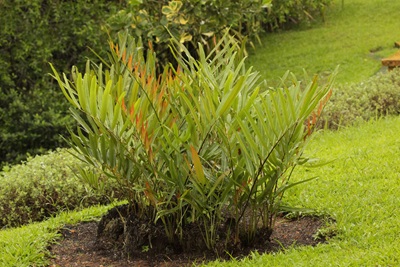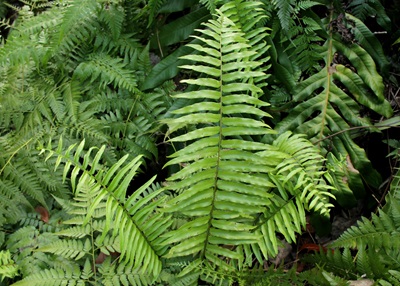Is It A Fern? Double Con-fern!
Ferns are an ancient group of plants – their fossil records date back to around 300 million years ago. As one of the earliest plant life forms, they do not flower and instead reproduce via spores on the undersides of their leaves.
Leaves of ferns are often referred to as a frond. New fronds are called crozier or fiddlehead, which is a tight spiral that unrolls as it grows.
Although flowerless and unassuming, that does not mean that they are any less beautiful. Whether you are walking along the street or in our parks or gardens, take time to look beyond the flowers and instead, admire the magnificent foliage that these native ferns display.
Birds’ Nest Fern
_jeanne-tan.jpg?h=267&w=401)
Photo credit: Jeanne Tan
The Birds’ Nest Fern (Asplenium nidus) is a large epiphytic fern that is commonly seen on many trees in Singapore. Its leaves can be up to 1.5 m or more in length, and up to 20 cm wide.
It is easy to grow, preferring moist soils and semi-shaded or full sun conditions, and can be used as an ornament in in parks and gardens. It is said that its leaves are edible and some people believe that an infusion of its leaves can be used to ease labour pains and a lotion obtained from its leaves can be used to treat fever.
Staghorn Fern
_ang-wee-foong-cropped.jpg?h=526&w=400)
Photo credit: Ang Wee Foong
Another large epiphytic fern, the Staghorn Fern (Platycerium coronarium) can be found perched on the upper branches of mature trees with wide spreading crowns and sparse foliage. It can grow up to 3 m long and 1.5 m across when fully grown.
Infertile nest-fronds are fan-shaped and topped by erect lobed ‘fingers’, while the fertile fronds are long and pendulous, forming a net-like structure below. New nest-fronds successively grow on the outside, replacing aged fronds which die and curl up to grip the leaf litter inside. The fern’s roots grow into this mass of decaying leaves for moisture and nutrients.
Tree Fern
_jeanne-tan.jpg?h=533&w=400)
Photo credit: Jeanne Tan
This is a fern that looks like a tree! The Tree Fern (Alsophila latebrosa) is the largest native fern in Singapore. It grows near forest fringes and can reach up to 4 m in height with a palm-like shape.
The leaflets have tiny brown spots on their undersides, which are the spores cases that enclose thousands of spores. Its leaf fronds are bipinnate, which means that the leaflets are further subdivided in a pinnate arrangement (on both sides of the stem in opposite pairs).
The Tree Fern grows best in moist soils and with its attractive palm-like habit and large leaf fronds, it makes an attractive ornamental plant for shaded areas.
Mangrove Fern

Photo credit: Arthur Ng
A native, the Mangrove Fern (Acrostichum aureum) grows well in waterlogged soils, and can reach up to 3 m tall, bearing attractive young fronds that are orangey-red. It can be grown under full sun or partially shaded conditions. The young fronds are said to be edible.
While it grows best along the landward side of mangrove forests because it is less tolerant of frequent seawater inundation, it does sometimes grow near the sea in the absence of mangrove forests. You may find it growing naturally in Pulau Ubin and many other coastal sites.
Broad Sword Fern

Photo credit: Arthur Ng
Sometimes grown for its ornamental foliage, the Broad Sword Fern (Nephrolepis biserrata) produces leaf blades that are large, measuring between 1 to 1.5 m long each and about 30 to 40 cm wide.
While it is native to Singapore, the Broad Sword Fern can also be found in other Southeast Asian countries, Australia, the Pacific Islands as well as in North and South America.
Can’t get enough of the beauty of ferns? Why not try growing some in your home? We give you some tips to do so here.
Besides ferns, learn more about other natural heritage by identifying 10 native plants of Singapore here.
Gardeners’ Day Out Is Back!
Participate from the comfort of your home with online activities such as talks and demonstrations, video tutorials of activities and promotions offered. Free guided tours will also be offered on site (with safe management measures). Enjoy Gardeners’ Day Out online at www.nparks.gov.sg/GDO.
You can also enjoy our Gardening With Edibles Masterclass Series from your home. They are conducted by NParks horticulturists, focusing on unique and challenging edibles across different plant families.
Learning More
If you are heading to our green spaces, do the right thing and be socially responsible. Maintain a safe distance from other park goers and keep to not more than eight persons in a group, with no intermixing between groups. Always wear a mask except when you are engaged in strenuous exercise or when consuming food, drink or medication.
Do check out the visitorship levels of our parks using our safe distancing portal before you head down and avoid the ones with high visitorship. Learn about some simple do’s and don’ts when visiting our Nature Reserve and Nature Parks here.
Visit NParksSG, our refreshed YouTube Channel that serves as a one-stop repository for close to 300 video resources. It also provides you a platform for existing and future digital outreach including DIY gardening and related crafts, virtual tours of our green spaces, and livestream events.
Whether you are an amateur gardener or a seasoned horticulturist, starting a home garden or a community garden, there are plenty of useful information and guides here for your gardening hobby.
For more information about the flora and fauna found in Singapore, please visit NParks Flora and Fauna Web.
If you like what you read, follow us on Facebook, Instagram and Telegram to get the latest updates.
Text by Charlotte Tan and Felix Siew




/origanum-vulgare---overall---hp-herbs-gdn.jpg)
Have views or comments on this article? Let us know via this form. If you would like to give us feedback on any other areas relating to our parks and gardens, please submit via https://www.nparks.gov.sg/feedback